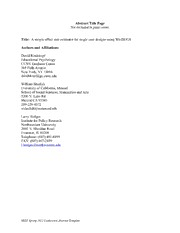Table Of ContentAbstract Title Page
Not included in page count.
Title: A simple effect size estimator for single case designs using WinBUGS
Authors and Affiliations:
David Rindskopf
Educational Psychology
CUNY Graduate Center
365 Fifth Avenue
New York, NY 10016
drindskopf@gc.cuny.edu
William Shadish
University of California, Merced
School of Social Sciences, Humanities and Arts
5200 N. Lake Rd
Merced CA 95343
209-228-4372
wshadish@ucmerced.edu
Larry Hedges
Institute for Policy Research
Northwestern University
2040 N. Sheridan Road
Evanston, IL 60208
Telephone: (847) 491-8899
FAX: (847) 467-2459
l-hedges@northwestern.edu
SREE Spring 2012 Conference Abstract Template
Abstract Body
Limit 4 pages single-spaced.
Background / Context:
Description of prior research and its intellectual context.
Data from single case designs (SCDs) have traditionally been analyzed by visual inspection
rather than statistical models. As a consequence, effect sizes have been of little interest. Lately,
some effect-size estimators have been proposed, but most are either (i) nonparametric, and/or (ii)
based on an analogy incompatible with effect sizes from group-based studies.
Purpose / Objective / Research Question / Focus of Study:
Description of the focus of the research.
As part of a research program conducted by Shadish, Hedges, and Rindskopf, this paper reports a
beginning step to fill the gap between effect sizes in SCDs and in group-based designs. When,
as is typically the case, an SCD involves multiple participants, it is possible to use variation
among participants as a denominator in an effect size measure, as is done in between-group
research. A simple estimator of this type can easily be implemented using WinBUGS, a
Bayesian program that has extreme flexibility.
Setting:
Description of the research location.
(May not be applicable for Methods submissions)
(Not applicable)
Population / Participants / Subjects:
Description of the participants in the study: who, how many, key features, or characteristics.
(May not be applicable for Methods submissions)
(Not applicable)
Intervention / Program / Practice:
Description of the intervention, program, or practice, including details of administration and
duration.
(May not be applicable for Methods submissions)
(Not applicable)
Significance / Novelty of study:
Description of what is missing in previous work and the contribution the study makes.
As far as we know, there is no previous work that is comparable. Other approaches to this
problem have used within-subject variation as the denominator in computing effect sizes.
SREE Spring 2012 Conference Abstract Template 1
Statistical, Measurement, or Econometric Model:
Description of the proposed new methods or novel applications of existing methods.
It is becoming well-known that when an SCD involves at least a small group of participants,
multilevel models provide a useful statistical framework for the analysis of data. Overviews of
this include several papers by van den Noortgate and Onghena (2003a, 2003b, 2007, 2008). One
problem with the usual methods of estimation (e.g SAS MIXED, HLM, SPSS Mixed) is that they
rely on large samples in order for the estimates to have good statistical properties. Fully
Bayesian (as opposed to empirical Bayesian) methods do not have this limitation, and are more
appropriate for most SCDs. The WinBUGS software (Spiegelhalter et al., 2002) will easily fit
these models using fully Bayesian estimation, through the Markov Chain Monte Carlo (MCMC)
sampling procedure.
In addition to being fully Bayesian, WinBUGS has enough programming facilities that we can
write code to calculate an effect size estimate, and, just as importantly, to estimate its standard
error. This will make it possible for SCD researchers to have their results included in meta-
analyses and other quantitative research syntheses. As a practical issue, the lack of this
capability has prevented SCD results from being included in most What Works Clearinghouse
(WWC) reports.
Usefulness / Applicability of Method:
Demonstration of the usefulness of the proposed methods using hypothetical or real data.
The paper includes an example from a published SCD research study, with WinBUGS code.
Research Design:
Description of the research design (e.g., qualitative case study, quasi-experimental design,
secondary analysis, analytic essay, randomized field trial).
(May not be applicable for Methods submissions)
(not applicable)
Data Collection and Analysis:
Description of the methods for collecting and analyzing data.
(May not be applicable for Methods submissions)
(not applicable)
Findings / Results:
Description of the main findings with specific details.
(May not be applicable for Methods submissions)
(not applicable).
SREE Spring 2012 Conference Abstract Template 2
Conclusions:
Description of conclusions, recommendations, and limitations based on findings.
These methods should be useful for SCD researchers who wish to have their results included in
research syntheses. We intend to extend the method in several ways, including adding an
autocorrelation to account for serial dependency.
SREE Spring 2012 Conference Abstract Template 3
Appendices
Not included in page count.
Appendix A. References
References are to be in APA version 6 format.
Spiegelhalter, D., Thomas, A., Best, N., and Lunn, D. (2002). WinBUGS User Manual Version
1.4, Cambridge, UK: MRC Biostatistics Unit
Van den Noortgate, W. & Onghena, P. (2003a). Combining single-case experimental data using
hierarchical linear models. School Psychology Quarterly, 18(3), 325-346.
Van den Noortgate, W. & Onghena, P. (2003b). Hierarchical linear models for the quantitative
integration of effects sizes in single-case research. Behavior Research Methods, Instruments,
& Computers, 35(1), 1-10.
Van den Noortgate, W. & Onghena, P. (2007). The aggregation of single-case results using
hierarchical linear models. The Behavior Analyst Today, 8(2), 196-209.
Van den Noortgate, W. & Onghena, P. (2008). A multilevel meta-analysis of single subject
experimental design studies. Evidence-Based Communication Assessment and Intervention,
3, 142-151.
SREE Spring 2012 Conference Abstract Template

